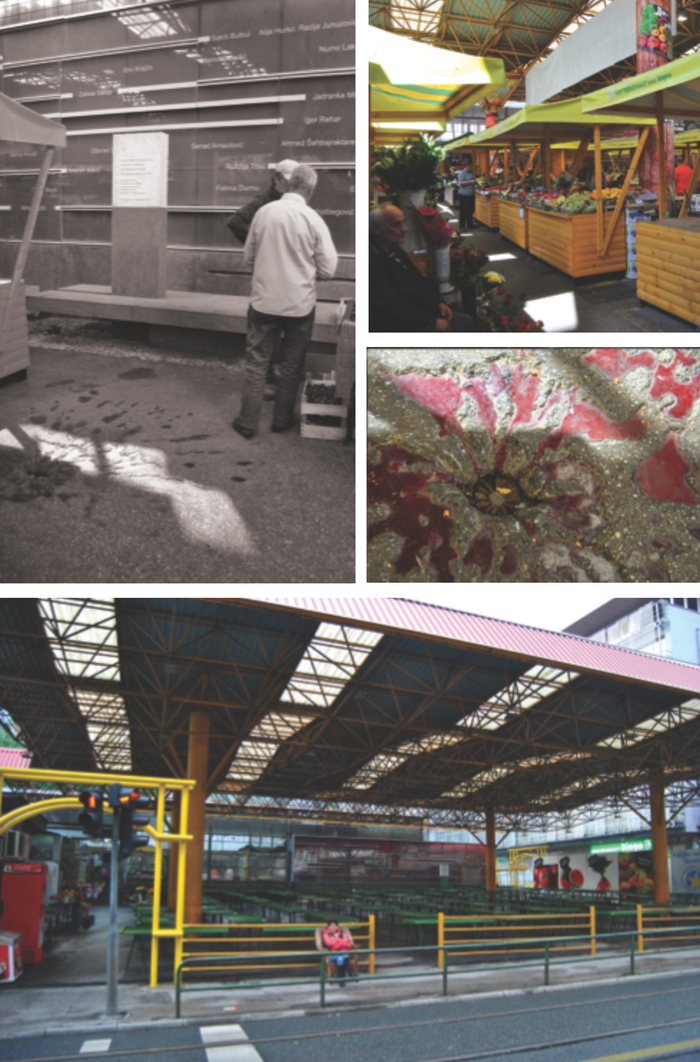3.1. Sites of Memories: Markale Market
Markale Market in the very center of Sarajevo is one of the sites that is commemorated due to the great loss of life. It was the scene of two artillery bombardments, one of which took place in 1994, killing 68 people and injuring 144. The second took place in the following year, killing 43 and injuring 84 (Mackic 2018). These sites are remembered not only by those who were near the site and survived or those who rushed to the aid of the injured and barely alive. The place is also remembered because it was quickly reachable by television crews in the aftermath of the event. The events and subsequent coverage resulted in some of the most shocking sound and images captured during the siege of Sarajevo, and they are engraved in people’s minds.
In rare times during the war when electricity was available and adults were watching the news, [as a child], I was shouted at to go to another room, to play, and not to see, not to see the footage of Sarajevo broadcast by CNN and watched in my city. The sound couldn’t be escaped or muted, and the sound of a suffering person in pain is so uniquely and universally human across geographic areas. (Zećo 2019: 140)
Offering footage of the massacre, along with a few other iconic images, as a symbol of the siege of Sarajevo is an example of the crucial role fulfilled by war journalists. The Balkan conflict was the first war on the European continent after the Second World War, and media attention was directed toward Bosnia and Herzegovina. Internationally, footage of the conflict, featuring struggling civilians and refugees, flooded viewers’ television screens around the globe. The footage appeared at the time of the rise of reality TV and soap operas at the dawn of the age of satellite TV. This “CNN effect,” as it was called, meant that war became “real” through the broadcast of images (Sontag 2003: 105). This is one illustration of “the determining influence of photographs in shaping what catastrophes and crises we pay attention to, what we care about, and ultimately what evaluations are attached to these conflicts” (Sontag 2003: 105).
Listening in Markale Market now, as an emotionally charged place, I notice that merely slowing down to listen turns my attention from the openness of the space, street, and conversations to the specificities of this place, actualizing Tuan’s proposal that slowing down turns space into place (Tuan 1977). The space of a market inevitably becomes the place of the Markale Market. Memorialized images from news broadcasts, YouTube clips, documentaries, the sights and sounds of people being slaughtered by bombs creeps up uninvited and overwhelms the mind.
Although I practiced soundwalking throughout the project, it was not until this site that I realized that soundwalking as a practice of attentive listening can activate memory retrieval. This occurs despite the sensory abundance (Rodaway 1994; Chion 2016) in which I am immersed while listening, here.
I notice the sounds that I am directing my attention to, what is happening behind me and in front of me, but I also notice the visual traces of history. Gradually, I become aware of the cognitive aspect of perception. Through the process of listening to sites imbued deeply with memory, meanings are created and feelings emerge. I then wonder where the memories come from.
In Markale Market, surrounded by walls covered with the names of the dead, it is very difficult to distinguish between a personal memory created by the direct experience of horror and what is a memory planted in the mind by the media. These images and sounds, once experienced, become part of one’s identity, of collective memory, and this consequently shapes how we listen to and sense a place.
When I listen to the sounds of Markale Market now, there are no sounds that act as pathetic triggers (Voegelin 2006). Visually, yes, there is a modest monument and a shell buried in the asphalt that many pass by daily without noticing. In this case, the site of the market itself acts as a pathetic trigger, and the memories that are triggered depend on the listener’s experience of the conflict. This might be direct experiences with these events or images and videos that were broadcast on television. Most Sarajevo residents still remember what they did on the days of the bombardment in 1994 and 1995, and if they did not experience it firsthand, they have memories of the footage.
Markale Market today is a place of remembrance. Every year the market is temporarily closed in order to receive politicians and members of the public commemorating the past. The next day it becomes again a site of exchange, of conversation superimposed on a collage of fresh fruits and vegetables – flowers for sale on one side and flowers of tribute lined on the street next to the monument on the other.

